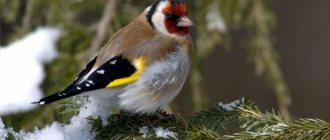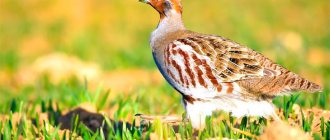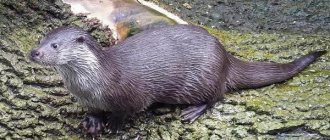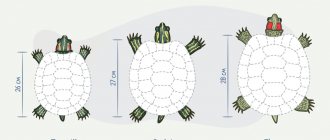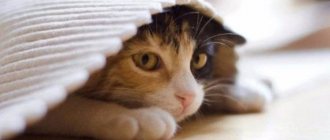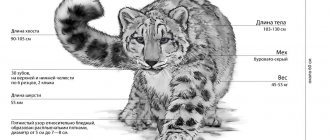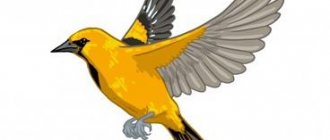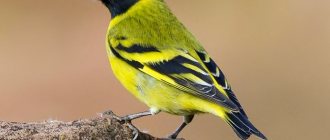- Wild animals
- >>
- Birds
The crossbill is an amazing songbird that is distinguished by its uniqueness in several ways. Firstly, this is an unusual shape of the beak, secondly, a bright and original color, and thirdly, the choice of a completely inappropriate time for the wedding season and having offspring. Let’s try to understand all these subtleties by studying the bird’s habits, disposition, external features and preferred habitats.
Origin of the species and description
Photo: Klest
Crossbills are small songbirds belonging to the order Passeriformes and the finch family. The crossbill can be called an ancient bird, because it is known that its ancestors inhabited our planet 9 or 10 million years ago. The main bird species were formed in the territories of spruce and pine forests located in the northern hemisphere.
Video: Klest
There are stories and legends about the crossbill, according to one of them it is called the bird of Christ. It is believed that when Christ was crucified and suffered on the cross, it was the crossbill that tried to save him by removing the nails from his body, which is why he bent his beak. The little bird did not have enough strength, except for its beak, the crossbill was injured, and its chest was stained with blood.
The Lord thanked the bird for its efforts and gave it unusual and amazing properties, which are:
- in a cross-shaped beak;
- the birth of “Christmas” feathered offspring;
- incorruptibility of bird's dust.
All these gifts of God are very unusual; they are connected with the life activity and appearance of the crossbill, which we will try to analyze in detail. The crossbill does not differ in large dimensions, it is slightly larger than an ordinary sparrow, the length of its body reaches 20 cm. The physique of the bird is quite strong and stocky, and the bird's tail is short and forked in half.
On a rather large-shaped head, an unusual and very original beak is immediately noticeable, the curved halves of which do not coincide and overlap crosswise. Bird paws are strong and have excellent tenacity, so the crossbill can hang head down on a branch. Male birds differ from females in their more elegant and attractive costume.
Description of the bird
The crossbill is a small bird slightly larger than a sparrow. This breed is characterized by an unusual appearance. The crossbill has a cross-shaped beak, which makes it stand out from the general mass of birds.
The name is of Latin origin (Loxia). Crossbills are songbirds. If we talk about generic affiliation, the crossbill belongs to the family of finches, to the order of passerines. Crossbills mainly live in the Northern Hemisphere. The dominant elements in their diet are the seeds of coniferous plants and pine cones. Crossbills are capable of traveling an impressive number of kilometers to feed - 2700-3500 km from the nest.
Appearance
— Advertising —
To recognize a crossbill, you should look at its beak - it is cross-shaped, characteristic only of this species of bird. In the color of its plumage, this bird is distinguished by the contrast of shades on the body. The predominant colors are: green, orange, gray-yellow, white. Sometimes the color scheme can even include a bright crimson hue, but this is typical only for males. The tail is divided into two halves. In general, crossbills have a powerful body and short neck, which add additional roundness to their appearance.
The size of this bird is not large in size, only 17-20 cm in length, and no more than 50-60 grams of weight.
Male and female: differences
Crossbills have well-expressed sexual dimorphism - males are brighter than females.
— Advertising —
Typically, males have raspberry, orange, and green shades, while females have the whole range of pastels - gray-yellow, gray-white, muted green, fading into gray. Males and females are the same in body size.
In crossbills, the male is considered the breadwinner - it is he who, after the birth of the chicks and until their adolescence, takes care of their feeding.
Appearance and features
Photo: What a crossbill looks like
The dimensions of the crossbill are clear, but its weight varies from 50 to 60 grams. The bird's entire body appears rounded due to its dense and stocky body and short neck.
In the colors of the colorful plumage you can notice shades:
- orange;
- greenish;
- white;
- grayish yellow;
- reddish-crimson tones.
As already noted, the male looks much more interesting and extravagant, because has brighter plumage, in which red or crimson-red shades predominate, and its belly is lined with whitish-gray stripes. Females look much more modest, having feathers of gray and green colors, outlined by a yellow-green border.
In general, ornithologists distinguish five varieties of crossbills, three of which have permanent residence in our country: white-winged crossbill, spruce crossbill, and pine crossbill. Let us describe the characteristic external features of these birds using the example of specific species.
The spruce crossbill (common) has a body length of 17 to 20 cm. The male is characterized by a reddish-crimson color with a grayish-white belly. The faded color of the females contains gray-green and yellowish shades. The thin beak is not so strongly curved and has a slight overlap. The birds' heads are quite massive, and their weight ranges from 43 to 55 grams.
The pine crossbill is similar in color to the previous variety. It is distinguished by its immediately noticeable massive and thick beak, slightly blunted at the end. The length of the bird is 16–18 cm, and its weight is about 50 grams.
The white-winged crossbill is distinguished by the color of its wings, which have a white pattern in the form of stripes or spots; it is immediately visible against a black background. The male's plumage shows orange, crimson and red hues, while the female's plumage is yellowish-gray. The length of this crossbill is about 16 cm, and the weight varies from 43 to 50 grams.
The Scottish crossbill is endemic to the UK. Its dimensions are also small, the bird reaches from 15 to 17 cm in length and weighs 50 grams.
Description
The tenacity of its paws allows the bird to climb trees, hanging upside down from a pine cone. The breast color of males is crimson, while that of females is greenish-gray. The tails and wings of birds turn gray-brown. The singing of crossbills with high notes resembles chirping mixed with whistling. This is observed during flights. On the branches, the birds are silent.
There are several species of birds , three of which are the main ones and live in the vastness of Russia:
They are similar in habitat and diet. The names are intertwined with the characteristics of the species in the choice of coniferous forest species and the presence of white feathers.
Where does the crossbill live?
Photo: Klest in Russia
Crossbills are feathered inhabitants of coniferous forests of the northern hemisphere. They prefer coniferous and mixed forests, avoiding cedar thickets. To the question of whether crossbill is migratory or sedentary, we can answer that it is nomadic. The bird makes constant movements in search of food, without having a strictly defined location. Where there is a large harvest of coniferous trees, there is a large concentration of crossbills. After some time, crossbills may not be found where there were many of them a few months ago.
From the names of some species of these birds it is clear which forests the crossbill chooses for its place of residence. The spruce crossbill primarily prefers spruce forests, but also lives in mixed forests. This species inhabits Europe, the African mainland, the Philippines, Central Asia, North and Central America.
The pine crossbill likes pine forests; its habitat covers Scandinavia and northeastern Europe. It is much less common than the spruce crossbill. The white-winged crossbill inhabits the Russian taiga, the North American continent and Scandinavia, where it most often lives in places where larch grows. It is clear that the Scottish crossbill lives in the UK and is endemic.
Crossbills constantly migrate to places rich in food; in addition to forests, they can be found in the following areas:
- tundra;
- steppes;
- mountain ranges.
Interesting fact: Scientists discovered some of the crossbills that ornithologists had ringed 3,500 km from their previous habitats.
Crossbill varieties
In addition to the common crossbill, there are other varieties. Let's look at the most popular ones.
The color of the pine crossbill resembles the blossoming of tree bark: the plumage is brown with rare dirty yellow stripes. It differs from the ordinary species not only in the color of its plumage, but also in size and beak structure. The length of the bird is 16-18 cm. The mandible and mandible are thicker. The bird prefers pine forests, especially Scandinavia and North-Eastern Europe.
The white-winged crossbill is very similar to the spruce crossbill, but it has small white stripes on its wings, but the rest of the color is orange-red. The female has yellow plumage. The body length of both reaches 14-16 cm.
The Scottish crossbill, which inhabits the territory of Great Britain, has a delicate matte color. Its plumage is crimson with yellow and gray tints.
What does the crossbill eat?
Photo: Crossbill bird
Once you see how the crossbill deftly bends back the hard scales of the cones and takes out the seeds from under them, it immediately becomes clear why it was given such an unusual cross-shaped beak. The bird's tenacious paws firmly grasp the branches and help peck at the pine cones, hanging upside down.
You won't see much variety on the crossbills menu. Regarding their diet, these birds can be called highly specialized specialists in eating coniferous tree seeds, which are the main source of bird food. Crossbills often snack on sunflower seeds, but insects are only occasionally found on their menu; most often birds eat aphids.
Interesting fact: In summer times when food is scarce, crossbills happily peck wild grass seeds, and often in such hungry periods whole flocks of birds attack fields sown with cultivated plants.
Usually, when eating seeds from cones, only a third of them are pecked; the crossbill does not try to pull out seeds that are difficult to yield; it is much easier for him to start pecking at another cone. Cones that are not completely eaten also do not disappear; throwing them to the ground, the crossbill feeds rodents, squirrels and other lovers of such food. Crossbills eat spruce and pine buds, resin along with tree bark. The bird will not refuse maple, ash, fir and larch seeds. Crossbills living in captivity happily eat rowan berries, oatmeal, mealworms, millet, hemp, nuts and sunflowers.
Now you know what to feed the crossbill. Let's see how a bird lives in the wild.
Flights, singing and diet
The crossbill does not like to sit still and leads a nomadic lifestyle during the day. Birds are perfectly adapted to the cold, and therefore there is no need for them to migrate to the south. However, throughout the year, individuals fly in large flocks from place to place in search of food. For food, birds are able to travel enormous distances - up to 3,500 km from the nest.
The singing of the crossbill resembles a whistle, clicking, squealing; it is very neat, quiet, flowing from one sound to another. It is most often heard during the day. The bird performs especially loud songs during flight: in the trees, songbirds are calm and silent.
Conifer cone seeds are the basis of the crossbill's diet. The cross-shaped beak allows the bird to slightly open the scales of the cone, very quickly and deftly scoop out the seeds, and throw the remains to the ground for the squirrels. Less commonly, individuals consume sunflower seeds, weeds and insects.
Features of character and lifestyle
Photo: Crossbill in nature
Crossbills are true nomads, constantly moving to places where there is a great abundance of the food they need. To do this, they gather in flocks of 20 or 30 individuals. They cannot be called either migratory or sedentary birds. These birds are active during the day, spending a huge amount of time in the tree crown, where they search for food. Birds rarely descend to the ground, preferring to be high in the branches. The crossbill is very mobile and dexterous, it flies beautifully, and its flight path is usually wavy. These little birds are not at all afraid of frost, which is why they live in areas with a fairly cool climate.
Interesting fact: The white-winged crossbill feels great, even if the temperature outside is about 50 degrees minus. The bird continues its trills even in such frost.
Do not forget that the crossbill is a songbird. But he sings, most often when he makes his flight. It is very rare to see a crossbill sitting in the branches and singing songs; while sitting, it is usually silent, calling out to other birds only during migration. The crossbill's song is similar to chirping interspersed with a loud whistle; high, thin notes are immediately audible.
The character of a bird can be judged by individuals living in captivity. Bird lovers claim that crossbills are very sociable, friendly and trusting. Birds are easily tamed and have ingenuity; they can be taught some simple commands. The crossbill can imitate the voices of other birds, skillfully supplementing their trill with them.
Keeping at home
The crossbill is unusually interesting and socially active. They quickly get used to life in changing conditions, they are trusting and sociable .
They constantly move around the cage and can get out of it, showing ingenuity. The owners of many birds know what the crossbill-spruce mockingbird is like: it easily imitates the heard voices of other birds. In ancient times, traveling musicians taught crossbills to get lucky tickets or take part in fortune telling. Easy training in simple actions turns birds into pets. If a crossbill lives in a cage without proper nutrition and ambient temperature, it loses its crimson coloring, turns pale, and then dies. Keeping birds in conditions that suit them helps ensure that their bright colors remain unchanged and they live up to 10 years. In captivity, birds reproduce successfully if acceptable nesting conditions are met.
Fans of breeding new breeds of birds strive to achieve a variety of color and vocal variants, so it becomes clear how the crossbill suddenly acquires the voice of a canary or the clothes of a bullfinch. Studying and selecting crossbills is a fascinating activity that brings the joy of communicating with these ancient birds of nature.
Bird crossbill
Social structure and reproduction
Photo: Crossbill songbird
A special feature of crossbills is that their offspring can be born during the winter cold; it is not for nothing that they are called Christmas birds, because it is during this great holiday that they often acquire chicks. In central Russia, crossbills begin nesting in March. The second nesting period occurs at the end of summer or at the very beginning of the autumn season, when the seeds on larches and pines ripen. Where the harvest of coniferous seeds is very rich, birds build nesting sites even at the very peak of winter frosts.
Interesting fact: The wedding season of crossbills does not depend on a specific time of year, it is directly related to the yield of coniferous trees.
Crossbills make nesting sites on spruce trees; they use pine trees less often; they can be located at a height of 2 to 10 meters. The outside of the nest is woven from thin spruce twigs; inside, thin twigs and bedding made of moss, lichen, feathers, and animal hair are also used. The diameter of the nesting box is about 13 cm, and its height is from 8 to 10 cm.
The clutch of crossbill contains from three to five eggs, white with a slightly bluish tone, the shell of which is decorated with burgundy speckles. The incubation period takes two weeks. All this time, the female hatches her offspring, and the future father takes care of her food. The hatched babies are covered with gray and fairly thick fluff. For several days, the feathered mother warms the chicks with her body, and then they, together with the males, go for food for their babies.
Already at three weeks of age, the chicks begin to make their first flights, but they do not move long distances from the nesting site and spend the night there. It should be noted that chicks are born with a straight beak, so for the first few months, caring feathered parents feed them. The kids gradually begin to very skillfully cut up cones, and their beaks become like those of their adult relatives. Closer to the age of one year, the plumage of young birds becomes the same as that of mature birds. It should be noted that in favorable conditions of captivity, crossbills live up to 10 years; in the wild, their life span is shorter.
Habitat
The ancestors of modern crossbills are quite ancient, they are 7-9 million years old. The main population of crossbills originated in the coniferous forests of the Northern Hemisphere. Their settlement directly depends on the harvest of cones , which are the main food for the birds.
That’s why crossbills live both in the tundra and in forest-steppes and make long flights to places rich in food. There have been cases when they were found 2000 km from their nesting sites. In Russia they live in pine and spruce forests in mountainous areas in the southern regions of the country, in the northwest. The bird can be found in forests dominated by spruce trees. Spruce crossbills do not live in cedar forests. The bird has practically no enemies. This is explained simply: due to the consumption of coniferous seeds, birds embalm themselves during life and become too bitter for predators. After natural death, they become mummified, which is facilitated by their body containing a high content of pine resins.
Crossbills fly well, but it is impossible to say that the crossbill is a migratory or sedentary bird. The crossbill is more likely a representative of nomadic birds. The migration of birds is closely related to the harvest. In places saturated with food, birds endlessly climb trees , fortunately the shape of the beak of the crossbill makes it possible to do this without difficulty, like parrots. It is for this skill and the bright color of their feathers that they received the name “northern parrots”. They almost never descend to the ground, and they feel great on branches even if they turn over.
Natural enemies of crossbills
Photo: Crossbill bird
Crossbill was very lucky, because... it has practically no enemies in natural conditions. The thing is that for other animals and large birds the crossbill is not of gastronomic interest, because it is bitter and tasteless due to the fact that it constantly feeds on pine seeds. Thanks to the specific bird diet, the crossbill's body contains a high concentration of pine resins, thus, during its life, the crossbill embalms itself.
Interesting fact: After death, the crossbill’s body does not decompose, but turns into a mummy, all because of the same pine resin that fills its body. This confirms the legend about the incorruptibility of the bird’s body, which the Lord himself gave to the crossbill.
The enemies of the crossbill include people who do not directly destroy the bird, but greatly influence its life indirectly by interfering with natural biotopes, cutting down forests, and worsening the environmental situation in general. Continuous economic and human activity has a detrimental effect on the size of the bird population, the number of which is gradually decreasing. Crossbills do not mind severe frosts and harsh life in the taiga forest thickets. The bird is not afraid of dangerous predators; only human activity poses a significant threat to the birds.
Interesting fact: To feed their chicks, crossbills soften pine seeds in their crops, making them easier for the babies to swallow and digest.
Reproduction
Crossbill chicks, unlike other birds, appear in winter, often at Christmas , as a blessing from the Almighty, according to legend.
Food reserves contribute to this. The female builds a nest at the top of coniferous trees or under the cover of spreading branches from rain and snow. The construction of nests begins with the first frosts and is done taking into account all the harsh tests: with a warm lining of moss, animal hair, lichens, and bird feathers. The walls of the nest boast strength: the woven twigs create several layers, internal and external. The nest is often equated to a thermos in terms of maintaining a constant temperature environment. In winter, the crossbill, despite the frosts, is quite active to provide for its offspring.
Incubation of a clutch of 3-4 eggs lasts on average 15 days . During this time, the male takes care of the female in every possible way, feeding her with seeds softened in the crop. Chicks already leave their nest from 5-20 days of life. Their beak is straight at first, so the parents spend a month feeding the young.
When the beak takes its shape, the chicks begin to master the science of extracting seeds from cones and, together with the new beak, begin to live independently. The crossbill chick does not immediately have beautiful colored plumage. At first its color is gray with spots. Only after a year has passed do the birds change their clothes to adult ones.
Population and species status
Photo: What a crossbill looks like
Regarding the size of the crossbill population, it is impossible to say unambiguously what position it is in. The thing is that almost all species of these birds constantly move from territory to territory in search of places rich in food typical for birds. It happens that where crossbills were numerous, after a few months they completely disappear, moving to new areas, and appear in places where they had not previously been observed in large numbers. It has been noticed that the number of livestock is constantly changing from year to year in different regions. Apparently, this depends on the yield of coniferous trees.
Interesting fact: In the old days, traveling artists and musicians had tamed crossbills that could use their beaks to get lottery tickets and participated in a variety of fortune-telling, performing learned tricks.
Fluctuations in numbers are most often characteristic of the spruce crossbill; such fluctuations are not observed in the pine tree; it is considered a much less common species, although these two varieties coexist peacefully among themselves. As already mentioned, the population of crossbills in many regions suffers due to constant human activity, displacing birds from their inhabited and familiar places. Deforestation of coniferous forests has a very negative impact on the livelihoods of these songbirds. In some areas, crossbills are becoming less and less common, which causes concern among conservationists, so special protective measures are being introduced in such areas to promote a favorable and happy bird life.
Crossbill feeding
It is a misconception to think that crossbill feeds exclusively on the seeds of spruce or pine cones, although this is its main diet. The beak of the crossbill tears off the scales, exposing the seeds, but only a third of the cone is spent on food.
The bird does not bother with hard-to-reach grains; it is easier for it to find a new cone. The rest flies to the ground and feeds mice, squirrels or other forest inhabitants for a long time.
The crossbill feeds additionally, especially during the period of cone crop failure, on the buds of spruce and pine, gnawing off the protruding resin on the branches along with the bark, seeds of larch, maple, ash, insects and aphids. In captivity, he does not refuse mealworms, oatmeal, rowan, millet, sunflower and hemp.
White-winged crossbill
Crossbill Reproduction
Unlike other birds, crossbills hatch chicks in the coldest time - in winter, often at Christmas, as a blessing from God, according to legend. This is facilitated by food reserves.
Nests are built by the female crossbill on the tops of conifers or on branches under the reliable protection of large needle-like paws from rain and snow. Construction begins with the onset of the first frosts and is done taking into account the most severe tests: with an insulated bedding made of moss, the hair of various animals, bird feathers, and lichens.
The walls of the nest are durable: skillfully intertwined twigs form the inner and outer layers, otherwise the double walls of the home. The nest is often compared to a thermos in maintaining a constant temperature environment. The crossbill in winter , despite the frosts, is active enough to provide for its offspring.
Pictured is a crossbill's nest
Incubation of a clutch of 3-5 eggs lasts 15-16 days. All this time, the male cares for the female, feeding her with seeds heated and softened in the crop. Chicks of 5-20 days of life in different species already leave the nest. At first their beak is straight, so the parents feed the young for 1-2 months.
And then the chicks master the science of cutting up cones and, together with their changed beak, begin an independent life. The crossbill chick does not immediately receive colored clothes. At first the color of the plumage is gray with scattered spots. Only at the age of one year do birds turn into adult clothes.
